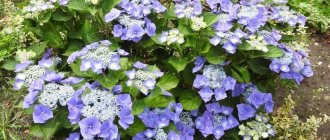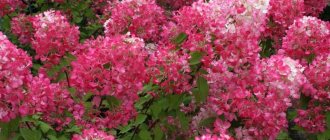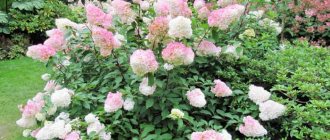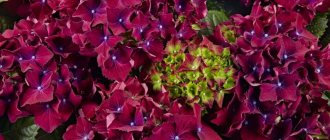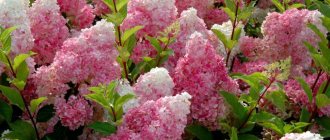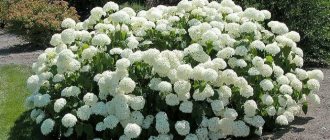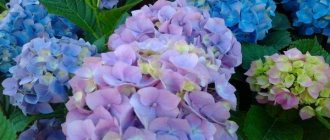Hydrangea Hayes Starburst is an artificially bred tree-like terry variety, which is considered to be native to the southern United States. Spreading bushes with large dark green leaves from June until autumn frosts are decorated with lush umbrellas of small milky-white flowers, shaped like stars. The frost resistance and unpretentiousness of Hayes Starburst hydrangea allows it to be grown both in conditions with a mild warm climate and in cold northern regions. This beauty will become a wonderful decoration of any garden, provided that a suitable place on the site is chosen for it and simple but proper care is provided.
Description of Hydrangea tree Hayes Starburst
Tree hydrangea Hayes Starburst takes its name in honor of Hayes Jackson, a gardener from Anniston (Alabama, USA). This is the world's first variety of tree hydrangea with double flowers. Its appearance was the result of a “happy accident” - a natural mutation of the popular Annabel variety of the Khowaria series. The plant was named “Starburst” due to its white flowers with sharp petals, which, when fully opened, resemble rays scattering in three-dimensional space.
Important! The Hayes Starburst hydrangea variety can sometimes be found under the name "Double Annabelle" or "Terry Annabelle".
Hayes Starburst is the world's only variety of double tree hydrangea.
The bush of the plant usually reaches 0.9-1.2 m in height, has a rounded spreading crown with a diameter of about 1.5 m. The shoots are long, thin, graceful, slightly pubescent. They grow quickly (up to 0.5 m during the season). The stems are straight, but not very strong.
Advice! Often, the shoots of Hydrangea Hayes Starburst can bend, unable to withstand the weight of the inflorescences. Therefore, the plant should be tied up or fenced with a circular support.
The flowers of Hydrangea Hayes Starburst are numerous and small (no more than 3 cm). Most of them are sterile. The petals of the plant are double with pointed tips. At the beginning of flowering, their color is slightly greenish, then it becomes milky white, maintaining a faint shade of green, and by the end of the season it acquires a light pinkish tone.
The flowers are collected in large, asymmetrical umbrellas about 15-25 cm in diameter, located at the ends of the current year's shoots. The inflorescences can be shaped like a sphere, a hemisphere or a truncated pyramid. The plant blooms from late June to October.
The leaves are large (from 6 to 20 cm), oblong, serrated along the edges. There is a heart-shaped notch at the base of the leaf blade. The leaves of the plant are dark green, slightly velvety on top, and bare and bluish on the underside.
Hydrangea Hayes Starburst bears fruit in September. These are a few small (about 3 mm), ribbed brown boxes. There are small seeds inside.
Trimming
Pruning tree hydrangea is an important part of care. Due to its rather wide and dense crown, hydrangea requires systematic pruning. It is better to carry out the procedure in early spring (III-IV), at the very beginning of the growing season, shortening all shoots above 2-3 eyes and completely removing frozen, weak and diseased shoots. When pruning, you should not be afraid of losing flowers; the plant forms flowers on annual shoots that grew in a given growing season.
Hortense Hayes Starburst in landscape design
The luxurious beauty Hayes Starburst is characterized by low maintenance, long flowering time and high decorative qualities. It looks great both in single plantings on grassy lawns and in group compositions, where it certainly attracts attention, becoming an exquisite decoration of the territory.
Options for the purpose of the Hayes Starburst hydrangea on the site:
- unshaped hedge;
- placement along structures or fences;
- division of zones in the garden;
- background plant in a mixborder or border;
- “camouflage” for a non-picturesque corner of the garden;
- combination with coniferous shrubs and trees;
- design of front gardens and recreation areas;
- landscape compositions with perennial flowers, plants of the lily family, as well as phlox, geranium, astilbe, barberry.
Hydrangea Hayes Starburst looks great both in compositions with other plants and in single plantings
Reviews
Most reviews of Hayes Starburst can be found on foreign websites. In our country, the variety is just beginning to fully take root. From the reviews that exist, it becomes clear that:
- this hydrangea is very unpretentious;
- in the first year after spring planting, you may not even see flowering;
- under the scorching sun, the number of flowers is greatly reduced.
Very little has been said about diseases. From this we can conclude that Hayesa copes well with them.
Tree hydrangea (Hydrangea arborescens) is one of the most commonly grown hydrangea species in gardens; its decorative qualities are great, the plant is not too bulky and copes well in our climate.
Planting and caring for Hydrangea Hayes Starburst
The hydrangea variety Hayes Starburst is considered unpretentious. However, the health of the plant, and, therefore, the duration and abundance of its flowering depends on how correctly the place for planting the bush is determined and what measures are taken to care for it.
A brief overview of the characteristics of the Hayes Stuburst hydrangea variety and the preferred garden conditions for this plant in the video
Selection and preparation of a landing site
The site where Hayes Starburst hydrangea is to be planted must have the following characteristics:
- semi-shaded throughout the day, but well lit by the sun in the morning and evening;
- protected from gusts of wind and drafts;
- the soil is light, fertile, humus-rich, slightly acidic, well-drained.
Hydrangea Hayes Starburst is light-loving, but can also grow in shaded areas. However, if there is an excess of bright sunlight, the flowering period of this plant will be shortened by about 3-5 weeks. If the bush is constantly in the shade, then the number and size of its flowers will be less than under optimal conditions.
The ideal option for Hayes Starburst hydrangea is planting in the northern, northeastern or eastern part of the garden. It is advisable that there is a fence, building wall or trees nearby.
A correctly selected area for planting is the key to lush and long-lasting flowering of hydrangeas.
Important! Due to the fact that tree hydrangea is very moisture-loving, it is not allowed to plant it near plants that absorb water from the soil in large quantities.
Landing rules
The time for planting Hayes Starburst hydrangea in an open area depends on the climatic region:
- in the north this is done in early spring, as soon as the ground has thawed sufficiently;
- in southern, warmer conditions, seedlings can be rooted in the ground either in the spring, before the buds swell, or in the fall, immediately after the leaves fall.
It is optimal to choose young 3-4 year old plants with a closed root system for planting.
Warning! The distance between hydrangea bushes on the site must be maintained at least 1 m, and to other trees and bushes there must be at least 2-3 m.
Immediately before planting, seedlings of the Hayes Starburst variety should be removed from the containers, the roots should be trimmed to 20-25 cm, and damaged and dry shoots should be removed.
The technology for planting tree hydrangea in the ground is as follows:
- it is necessary to prepare a planting hole approximately 30*30*30 cm in size;
- pour into it a heaping nutrient mixture of 2 parts chernozem, 2 parts humus, 1 part sand and 1 part peat, as well as mineral fertilizer (50 g superphosphate, 30 g potassium sulfate);
- place a plant seedling in the hole, straighten its roots, making sure that the root collar remains at soil level;
- cover with soil and compact it carefully;
- water the plant generously at the root;
- mulch the tree trunk circle with sawdust, peat, pine needles.
Watering and fertilizing
The root system of Hydrangea Hayes Starburst is shallow and branched. This plant is very moisture-loving and needs regular watering. The soil underneath should not be allowed to dry out.
The frequency of watering is approximately as follows:
- in the dry, hot summer period - 1-2 times a week;
- If it rains, then once a month will be enough.
The one-time water requirement for one Hayes Starburst hydrangea bush is 15-20 liters.
Simultaneously with watering, the soil in the tree trunks of the plant should be loosened to a depth of 5-6 cm (2-3 times during the season), and weeds should also be weeded.
Small double flowers of Hydrangea Hayes Starburst are shaped like stars.
Hydrangea Hayes Starburst is well suited to almost any fertilizer, but in moderation. They fertilize it according to this principle:
- for the first 2 years after planting in the ground, there is no need to feed the young plant;
- starting from the third year, in early spring, urea or superphosphate, nitrogen, potassium sulfate should be applied to the bushes (you can use a ready-made fertilizer mixture enriched with microelements);
- at the stage of bud formation, nitroammophoska is added;
- during the summer, every month you can enrich the soil under the plants with organic matter (infusion of chicken droppings, rotted manure, grass);
- in August, fertilization with nitrogen substances should be stopped, limiting it to formulations based on phosphorus and potassium;
- To strengthen the shoots during this period, it is necessary to spray the leaves of the plant with a weak solution of potassium permanganate.
Warning! Before applying fertilizer to the soil and after that, Hayes Starburst hydrangea must be watered.
It is also important to know that you cannot feed this plant with lime, chalk, fresh manure, or ash. These fertilizers greatly reduce the acidity of the soil, which is unacceptable for hydrangea.
Pruning Hydrangea arborescens Hayes Starburst
The Hayes Starburst hydrangea bush does not require pruning for the first 4 years.
Further, regular pruning of the plant is performed 2 times a year:
- In the spring, before sap flow begins, diseased, broken, weak branches and shoots frozen in winter are removed. At the budding stage, the weakest branches with inflorescences are cut off so that the remaining inflorescences are larger.
- In the fall, before the onset of winter, the dense growth is thinned out and the umbrellas that have bloomed are removed. Also during this period, the shoots that have grown over the year are reduced by 3-5 buds.
In addition, every 5-7 years it is recommended to carry out sanitary pruning of the plant, cutting off the shoots by about 10 cm.
Preparing for winter
In the northern regions, before the onset of winter, Hayes Starburst hydrangea bushes are mulched with dry leaves and covered with earth. In the southern climate, this procedure is carried out during the first 2 years after planting in open ground. It is also allowed to cover plants for the winter with coniferous spruce branches or insulate them with covering material.
To prevent the branches of the Hayes Starburst hydrangea from breaking under the weight of the accumulated snow, they are tied together, first carefully bending them to the ground
Choosing a landing site
The place for planting tree hydrangea is suitable both sunny and shaded. For these purposes, a pit measuring 0.5 by 0.5 meters is dug and filled with a fertile mixture of peat and humus. Filling the pit with soil specially designed for rhododendrons has a beneficial effect on the development of the plant and its subsequent flowering.
Experienced gardeners recommend adding hydrogel when tree hydrangea is planted as seedlings. This drug helps maintain water balance in the soil even in extreme heat. Penetrating into the swollen granules, the roots of the plant absorb as much moisture and nutrients as necessary. To do this, place the already swollen product in the pit, not the dry one. If you lay a dry hydrogel, then when it swells in the ground and increases in volume, the seedling may be pushed out together with the soil.
Also, when planting plants, pay attention to ensuring that the root collar of the seedling is flush with the surface of the ground. Then the plant is watered abundantly, soil is added and the tree trunk circle is mulched with pine litter or peat.
Reproduction
Most often, tree hydrangea Hayes Starburst is propagated using green cuttings, which are cut from young side shoots of the current year's plant. They are harvested in the summer, after buds appear on the bush, in this way:
- The cut shoots are immediately placed in water and placed in a dark place.
- Then remove the upper part with the bud and the lower leaves from the branch. The remaining part of the shoot is divided into several parts of 10-15 cm, each of which should contain 2-3 nodes with buds.
- The lower part of the cutting is cut under the first node, maintaining an angle of 45 °.
- The leaves also need to be shortened by half using scissors.
- Next, the cuttings are placed for 2-3 hours in a special solution (“Kornevin”, “Epin”), which stimulates plant growth and root formation.
- After this, they are placed in containers filled with water mixed with cinnamon powder (1 tsp per 200 ml) and wait until the roots appear.
- When the roots reach a length of 2-5 cm, the plants are planted in pots with moist soil from a mixture of garden soil, peat and sand. You can cover the cuttings with glass jars or cut plastic bottles for quick rooting (from time to time this cover should be opened slightly for ventilation).
- Pots with cuttings are kept in a shaded place. Water the seedlings 2-3 times a week.
- With the arrival of next spring, hydrangea is planted in the open air, after hardening the plants on the loggia or veranda.
The process of propagating hydrangea Hayes Starburst by cuttings is briefly and clearly shown in the photo:
The most popular method of propagating tree hydrangea is growing from green cuttings
Other methods of propagating hydrangea are also practiced:
- winter cuttings;
- dividing the bush;
- rooting of cuttings;
- separation of shoots (offshoots);
- seed germination;
- graft.
Application
Because of its lush growth, tree hydrangea looks best in large gardens and landscaped parks, planted solo against the background of a dark fence or green lawn. Low varieties are excellent for growing in small garden plots. The shrub goes well with other types of hydrangeas (paniculate, large-leaved and rough), creating beautiful and original compositions with them. Can be planted in combination with smaller plants that prefer semi-shaded areas, ferns and hosta. Hydrangeas make stunning, informal hedges, suitable for large gardens or large spaces. After flowering, the inflorescences remain on the shoots for a long time; after drying, they form an original winter garden decoration. The inflorescences are suitable for dry bouquets.
Diseases and pests
The main diseases and pests that can harm Hayes Starburst hydrangea are:
| Name of disease/pest | Signs of defeat | Prevention and control measures |
| Powdery mildew | Yellow-green pale spots on the leaves of the plant. On their reverse side there is a gray powdery coating. Rapid fall of green mass | Removal and destruction of affected parts. Fitosporin-B, Topaz. |
| Downy mildew (peronospora) | Oily spots on leaves and stems that darken over time | Removal of affected areas. Bordeaux mixture, Optimo, Kuproxat |
| Chlorosis | Large yellow spots on the leaves, while the veins remain green. Fast drying of foliage | Mitigation of soil acidity. Feeding hydrangeas with iron |
| Leaf aphid | Colonies of small black insects visible on the underside of leaves. The green mass of the bush dries out and turns yellow | Soap solution, decoction of tobacco dust. Spark, Akarin, Bison |
| Spider mite | The leaves curl and become covered with small reddish spots. Thin cobwebs are visible on their underside. | Soap solution, mineral oil. Akarin, Lightning |
Healthy hydrangea Hayes Starburst delights with flowers all summer until autumn frosts

